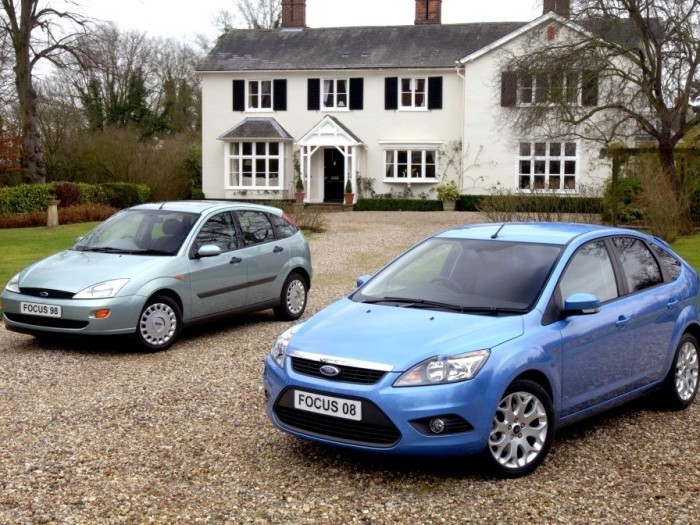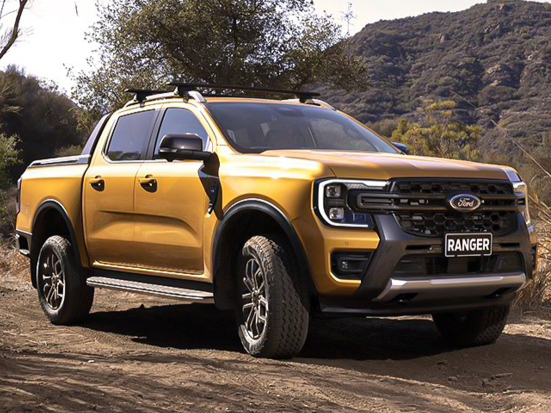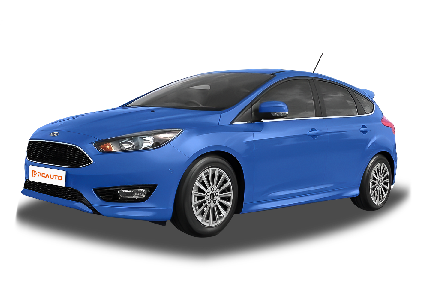Q
Is Ford Focus a good choice for first-time car buyers?
Yes, Ford Focus could be an excellent choice for first-time car buyers. It's priced at RM 131,986, which is quite reasonable for a car in this segment. With a top speed of up to 222 km/h and an acceleration time of 8.6 seconds from 0 to 100 km/h, it offers outstanding performance for both daily driving and highway cruising. The car runs on gasoline, and its official combined fuel consumption is 5.6 liters per 100 kilometers, which helps keep reduce the operating costs.
Safety is one of its major selling points. It comes standard with an Anti - lock Braking System (ABS), Electronic Stability Control, and multiple airbags, providing good protection. Comfort features like a dual - zone automatic climate control system, a Sony audio system, and power - adjustable seats enhance the driving experience. Moreover, the vehicle's size and its 421 - liter trunk offer ample space for daily use and short trips. Overall, it strikes a balance between performance, safety, comfort, and cost - effectiveness, making it an outstanding option for a first car purchase.
Special Disclaimer: This content is published by users and does not represent the views or position of PCauto.
Related Q&A
Q
What's the fuel consumption of Ford Focus?
The official combined fuel consumption of the 2017 Ford Focus 4-door sedan with a 1.5-liter EcoBoost engine, Titanium Plus Edition, is 5.6 liters per 100 kilometers. This figure is measured under specific test conditions stipulated by the manufacturer. However, in real-world driving, the actual fuel consumption can vary due to multiple factors.
For instance, driving style has a significant impact on fuel consumption. An aggressive driving style with frequent rapid acceleration and hard braking usually leads to higher fuel consumption, while smooth and constant-speed driving helps save fuel. Road conditions also play a role. Compared with driving on a flat highway with light traffic, driving on hills or in heavy traffic typically increases fuel consumption.
In addition, vehicle load, tire pressure, and the use of accessories such as the air - conditioning system can all affect the actual fuel consumption of the Ford Focus.
Q
What's the service life of Ford Focus' petrol engine?
The service life of the gasoline engine in the Ford Focus can be different. Generally speaking, if properly maintained, the service life of gasoline engine can last for more than 150,000 to 200,000 miles (about 240,000 to 320,000 kilometers) or even longer. The Ford Focus 1.5 EcoBoost Titanium+ is equipped with a 1498 - cc gasoline engine.
Regular oil changes are crucial because fresh oil lubricates the engine components, reducing friction and wear. Replacing filters, such as the air filter and fuel filter, also enables the engine to take in clean air and get the proper fuel mixture. Timely replacement of belts and hoses that age over time helps prevent unexpected breakdowns. Maintaining good driving habits is also important. Aggressive driving with sudden acceleration and hard braking will damage the engine, while smooth driving can extend the engine's service life. Additionally, following the manufacturer's maintenance schedule for the engine (for the Ford Focus, it might be maintenance at regular intervals of mileage or time) can ensure the engine stays in good working condition over the long term.
Q
Which one is better, Honda Civic or Ford Focus?
The Honda Civic and the Ford Focus each have their own advantages, making it difficult to simply judge which one is better. In terms of appearance, the front end of the Ford Focus has a dynamic design. Its large - sized aluminum alloy wheels are well - matched with the sporty taillight group, giving the car an overall fashionable and tech - savvy look. On the other hand, the Honda Civic may have a more simple and smooth shape.
When it comes to the interior, the Focus' 13.2 - inch floating central control screen creates an excellent technological atmosphere. It also comes with a large - sized sunroof, automatic air - conditioning and other complete configurations. The Civic's interior perhaps focuses more on the balance between comfort and practicality.
In terms of power, the Focus offers a variety of power options, including different turbocharged engines, providing plenty of driving fun. The Civic's power performance can also meet the needs of daily driving, and it may perform well in terms of fuel economy.
The prices of the two cars also vary depending on the specific models and configurations. It is recommended that you go to a dealership to test - drive these two models in person, experience their actual driving feelings, and then select the most suitable model for yourself based on factors such as your budget and your preferences for the appearance and interior.
Q
Is Ford Focus smaller than Corolla?
The 2017 Ford Focus Sedan 1.5 EcoBoost Titanium+ measures 4,534mm in length, 1,823mm in width, and 1,484mm in height, with a wheelbase of 2,648mm. The dimensions of the Corolla vary depending on the version and year. Generally, its length ranges from 4,300mm to 4,600mm, width from 1,700mm to 1,800mm, height from 1,450mm to 1,500mm, and wheelbase typically from 2,600mm to 2,700mm. As we can see, the Ford Focus is bigger than the common Corolla in length, width, height, and also longer in wheelbase.
However, the interior space of a car isn't solely determined by its exterior dimensions. Factors such as the in - car layout design also play a role in the actual space experience. Moreover, there are differences in the dimensions among different Corolla models. A detailed comparison requires the accurate parameters of the actual models. But when compared with the above - mentioned models, the Ford Focus has larger overall dimensions.
Q
Which one is better, Mazda 3 or Ford Focus?
Both Mazda 3 and Ford Focus have their own advantages, so which one is better depends on individual needs and preferences. In terms of price, if you have a limited budget, the Focus might be more suitable as it is relatively affordable. When it comes to configuration, the Mazda 3 has more abundant safety features. Even the base - model is equipped with a tire pressure monitoring system and a vehicle stability control system. Regarding power performance, the Focus is powered by a 1.5 - liter naturally - aspirated engine, while the Mazda 3 offers a choice between a 1.5L and a 1.4T engine, and the 1.4T engine provides stronger power. In terms of exterior design, the Focus has a more masculine look, while the Mazda 3 is more appealing to women. Moreover, the seams on the Mazda 3's center console are more delicate. In terms of space, some testers think that the Mazda 3 has a slight edge in headroom and legroom. All in all, if you focus on price and practicality, the Focus is a good option. However, if you prefer rich configurations and strong power, the Mazda 3 may be a better choice.
Q
What is the fuel economy of Ford Focus?
The official fuel consumption of the 2017 Ford Focus sedan 1.5-liter EcoBoost Titanium Plus Edition is 5.6 liters per 100 kilometers. This figure represents the combined fuel consumption under standard test conditions. In real-world driving, the fuel consumption may vary, which can be affected by factors such as driving style, road conditions, and vehicle load. For example, an aggressive driving style with rapid acceleration and hard braking may increase fuel consumption, while a smoother and more stable driving style may make the actual fuel consumption closer to the official data. Additionally, using features such as the air conditioner and having an excessive vehicle load can also affect the car's fuel consumption. The Focus's fuel consumption of 5.6 liters per 100 kilometers makes it a relatively fuel-efficient model in the compact car segment, helping car owners reduce their vehicle usage costs.
Q
Which model of Ford Focus is the best?
As the criteria for "the best" vary from different people, so it's quite difficult to directly determine which model is the best. Take the 2017 Ford Focus Sedan 1.5 EcoBoost Titanium+ as an example. It is equipped with rich configurations. In terms of power, the 1.5 - liter engine has a maximum horsepower of 182PS. The maximum speed can reach 222km/h, and it can accelerate from 0 to 100km/h in 8.6 seconds. Its power output has certain advantages among cars in the same class. Regarding safety features, it is standard - equipped with a series of safety systems such as ABS anti - lock brakes, vehicle stability control, and lane - change assist, and also has six airbags to comprehensively ensure the safety of drivers and passengers. There are also quite a few comfort features inside the car, like the dual - zone automatic air - conditioning in the front row and Sony speakers. However, if consumers pay more attention to fuel economy, its official combined fuel consumption of 5.6L/100km is quite good. If they prefer space, its 421L trunk volume is just average. So, the best model depends on individual's preferences.
Q
Is Ford Focus a small or mid-size car?
The Ford Focus is a small car, specifically a C-segment or compact sedan. It has a body length of 4,534 millimeters, a width of 1,823 millimeters, a height of 1,484 millimeters, and a wheelbase of 2,648 millimeters. These dimensions are typical specifications for a compact sedan. In the automotive classification, compared with mid-size or large vehicles, compact sedans are known for their relatively small size, which makes them easier to be driven in the city.
Compact sedans like the Ford Focus are popular among many consumers for their affordable price, good fuel economy, and easy parking. The Ford Focus is an excellent choice for daily commuting and city driving. And as a compact sedan, it also offers an ample interior space and features, such as a 55-liter fuel tank and 421 liters of trunk space.
Q
How far can a Ford Focus travel on an empty fuel tank?
Generally speaking, it's not recommended to drive your car until the fuel runs out completely, as this can potentially damage components like the fuel pump. However, in theory, if we estimate based on the information of the 2017 Ford Focus Sedan 1.5 EcoBoost Titanium+, its fuel tank capacity is 55 liters, and the official combined fuel consumption is 5.6 liters per 100 kilometers. Calculated at this fuel - consumption level, the theoretical driving range of this car when the tank is full is about 982 kilometers.
However, the actual range is affected by various factors. For example, driving style is an important factor. Frequent hard acceleration and sudden braking increase fuel consumption and reduce the range. Road conditions also play a role. Driving in congested traffic or on mountain roads can cause the fuel consumption to go up. Vehicle load is another factor. Having more passengers or carrying a large amount of items in the car will make it "thirstier" for fuel. So, in actual use, the range of this car will be less than the theoretical value, and the specific figure depends on the actual driving conditions.
Q
What is special about Ford Focus?
The Ford Focus has many distinctive features. It is equipped with a 1.5-liter EcoBoost engine that strikes a great balance between performance and efficiency. The maximum speed can reach up to 222 km/h, and the official 0 - 100 km/h acceleration time is 8.6 seconds. Meanwhile, the official combined fuel consumption is relatively low, at 5.6 liters per 100 kilometers.
In terms of safety, it is equipped with a series of standard features, such as six airbags, an Anti-lock Braking System (ABS), a Vehicle Stability Control system, and a variety of active safety systems. Comfort and convenience are also well - guaranteed. It offers a dual - zone automatic air - conditioning system and a Sony audio system for the front row, along with keyless operation and a single sunroof.
The interior design focuses on ergonomics, creating a "flight cockpit" feel. The 60:40 split - folding rear seats enhance the vehicle's practicality. Moreover, the exterior features a modern and dynamic design with sharp lines, which has won the favor of many consumers.
Latest Q&A
Q
proton x70 how many cylinder
Under the hood of the Proton X70 lies a 1.5-liter turbocharged four-cylinder engine, a straight-four design that's part of the advanced powertrain tech brought in after Proton's tie-up with Geely. It's a solid balance of performance and fuel efficiency – exactly what you want in a daily driver. The four-cylinder setup keeps things smooth and relatively quiet, which is perfect whether you're navigating Malaysian city traffic or hitting the highway for a longer run. Plus, it meets Euro 5 emissions standards, showing Proton's commitment to cleaner motoring.
For those who want to dig a bit deeper into the engine tech, it's worth checking out how cylinder configurations (like inline vs. V-type) affect a car's dynamics, or how turbocharging squeezes more power out of smaller engines – handy stuff to know when picking your next ride. As a popular SUV in the local market, the X70's powertrain is clearly tuned with our tropical climate and varied road conditions in mind. Just remember, regular maintenance is key to keeping that engine running at its best.
Q
what engine does proton x70 use
The Proton X70 offers two engine options: a 1.5-liter turbocharged direct injection (TGDI) powerplant and a 1.8-liter turbocharged unit. The 1.5TGDI churns out 177 horsepower and 255 Nm of peak torque, while the 1.8T steps it up to 184 horsepower and 300 Nm. Both are paired with a 7-speed dual-clutch transmission (DCT), striking a solid balance between performance and fuel efficiency.
As a top-selling SUV in Malaysia, the X70's powertrains trace back to the modular platform developed jointly by Geely and Volvo—proven technology you can rely on. The 1.5TGDI, in particular, benefits from lightweight construction and small-displacement turbo tech, making it a natural fit for Malaysia's urban streets and highway cruises alike.
Turbocharging really shines here by boosting low-end torque, giving the X70 that extra zip needed for Malaysia's hilly terrain and stop-and-go traffic. Meanwhile, direct injection optimizes fuel combustion, helping to keep running costs in check. Proton's engine choices clearly reflect a focus on versatile driving scenarios—whether it's your daily commute or a family road trip, the X70 delivers a well-rounded performance. Toss in that ASEAN NCAP 5-star safety rating, and you've got a compelling, value-packed option for Malaysian buyers.
Q
how to install youtube in proton x70
If you're looking to get YouTube up and running on your Proton X70, here's the lowdown: First off, the X70's stock infotainment system is Android-based, but Proton doesn't preinstall YouTube—makes sense, right? They’re probably thinking about safety and keeping your eyes on the road. But if you’re set on installing it, here’s how to go about it.
First, make sure your ride is parked and connected to a solid Wi-Fi network—can’t stress that enough, don’t try this while driving. Head into your system settings, tap on "Security & Privacy," and flip the switch to allow installations from "Unknown Sources." Next, fire up the built-in browser and download the YouTube APK file. Pro tip: Stick to the official site or super reliable third-party platforms to avoid any sketchy downloads. Once it’s downloaded, hit install and you should be good to go.
Now, a word of caution: Sideloading apps like this might mess with your system stability, and let’s not forget—it could potentially void your warranty. So think twice before diving in. Also, using video apps while driving is a huge safety no-no. Malaysian law strictly bans messing with entertainment systems when you’re behind the wheel, so save the YouTube binges for when you’re parked.
If you want to level up your in-car entertainment without the hassle, why not just use CarPlay or Android Auto? Mirroring YouTube from your phone that way is totally legal and way kinder to your X70’s factory system.
As one of Malaysia’s favorite homegrown SUVs, the Proton X70’s smart system gets regular updates. Do yourself a favor and check for official feature upgrades every now and then—you might score some cool new stuff that way. Drive safe out there!
Q
how to change proton x70 key battery
To replace the key battery in your Proton X70, start by grabbing a CR2032 coin battery – that's the standard type you'll find in most remote keys these days. Next, take a small screwdriver or even a coin and gently pry open the seam of the key fob. Go easy here to avoid scuffing or cracking the plastic case. Once you've popped the case apart, the battery compartment will be right there. When removing the old battery, use something non-metallic to avoid any short circuits, then drop the new battery in with the positive (+) side facing up. Snap the case back together and give all the key functions a test to make sure everything works like normal.
The X70's key is pretty straightforward, so swapping the battery isn't much different from other car brands. If you're ever unsure about the steps though, don't guess – check the owner's manual or swing by a Proton authorized service center. It's better to play it safe than risk damaging the key.
While we're on the topic, it's a good idea to keep an eye on your key battery life. No one wants to be stuck with a dead key fob when they're trying to unlock or start their car. If you notice the remote range getting shorter or the buttons feeling unresponsive, that's usually a telltale sign the battery is on its last legs. Swapping it out early saves you from a frustrating situation later.
And let's not forget Malaysia's humid weather – it can be tough on the key's internal electronics. Beyond just changing the battery, make sure to keep your key dry. Avoid getting it wet or leaving it baking in direct sunlight for hours. A little care goes a long way in keeping that key working smoothly for longer.
Q
how to use proton x70 cruise control
To use the cruise control on the Proton X70, first make sure you're cruising at over 40km/h. Hit the cruise control button on the left side of the steering wheel—it usually has a "CRUISE" icon. You'll see a cruise control standby indicator pop up on the dashboard. Once you're up to your desired speed, press the "SET-" button to lock it in. The system will maintain that speed automatically, so you can take your foot off the gas. Need a little more or less speed? Just tap "RES+" to speed up or "SET-" to slow down slightly. To temporarily disengage, a light tap on the brake or hitting "CANCEL" works. For a full shut-off, press the "CRUISE" button again.
A quick heads-up: cruise control shines on highways or long stretches with steady traffic, but switch back to manual when things get congested or the road gets twisty—safety first, folks. Also, remember the X70's system is conventional Cruise Control (CCS), not the fancier Adaptive Cruise Control (ACC) that adjusts speed based on the car ahead. That said, it still does a solid job of cutting down on driver fatigue. Do yourself a favor: flip through the owner's manual before using it, and keep an eye on your brakes and other key components to make sure everything runs smoothly.
View MoreRelated News

Ford Focus will cease production in 2025, shifting strategic emphasis towards electrification
Kevin WongMar 10, 2025

Ford Focus is about to cease production in November and may return in 2027 in the form of an SUV.
WilliamSep 15, 2025

2025 Ford Ranger WildTrak launched, the most powerful diesel version in the Ranger lineup
MichaelAug 25, 2025

Is the Ford Ranger V6 about to enter Malaysia?
LienAug 13, 2025

Reviewing the Ford Ranger: The Dual Advantages of Rugged Appearance and Powerful Performance
Kevin WongApr 21, 2025
View More

















Pros
Cons